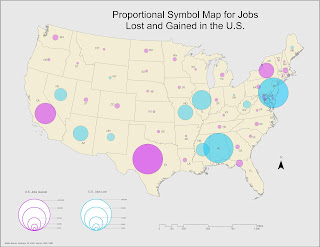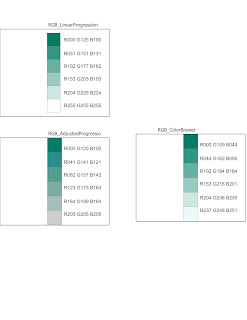GIS5935 Module 9-- Accuracy
This lab wraps up our modules to do with Surface analyses. Our first objective was to calculate and interpret the vertical accuracy of a DEM using NDEP accuracy guidelines. The second objective was to observe the effects of interpolation methods on a DEM's accuracy.
In the first accuracy analysis sample points appeared to be laid out in clusters instead of a natural distribution in which certain Land Cover types exhibit common areas. I’m leaning towards estimated interpolation causing this type of distribution because there is a notable gap of data points in higher elevation areas. I was able to plot a total of 2387 points from a provided table using the Make XY Event Layer tool. Then clipped the data points to the DEM extent.
The analysis for part 2 of the lab began by creating the 3 interpolated surfaces for IDW, Spline, and Krigging using the Pts95percent point data. Then added the Pts5percent point data to analyze differences in elevation using the Identify tool. In order to extract elevation points from all three interpolations using the 5% sample point data, I used the Extract Multi Values to Points tool for each interpolation which added an elevation field for that interpolation to the 5% sample point attribute table. From there, I was able to use the DBF file for Pts5percent in Excel to create a table and determine the differences between the true elevation and the interpolated elevations.
IDW interpolation seemed to do a better job at predicting elevation. It was the interpolation with the smallest amount of summary statistic differences for its elevation measurements.
In the first accuracy analysis sample points appeared to be laid out in clusters instead of a natural distribution in which certain Land Cover types exhibit common areas. I’m leaning towards estimated interpolation causing this type of distribution because there is a notable gap of data points in higher elevation areas. I was able to plot a total of 2387 points from a provided table using the Make XY Event Layer tool. Then clipped the data points to the DEM extent.
In order to be able to perform an analyses of the DEM and the reference point dataset, I extracted elevation values from the DEM and created a new set of points using the Extract values to Points tool. Then used the Extract Multi Values to Points tool to get Lidar values for the reference points. There was already elevation data in meters, so what I needed to use for calculations was the Z-pixel values and convert these values into meters. Using the DBFs from both point datasets in Excel, I was able to better manipulate and organize RMSE calculations for all five Land Cover types. Once I had main values set, I referred to the NDEP Guidelines for Digital Elevation Data document to check the standard value of 95% accuracy, which was 1.9600, and 1 for 68%. These values were then multiplied with the RMSEs to acquire final accuracy metrics.
My results came out a lot smaller than expected, to be honest (as seen below). Surely something went wrong and I'm going to look into this further.
Accuracy Metric (m)
|
Bare earth and
low grass (a)
|
High grass, weeds and crops (b)
|
Brush land and low trees ( c)
|
Fully forested (d)
|
Urban ( e)
|
Combined
|
Sample size
|
48
|
55
|
45
|
98
|
41
|
287
|
Accuracy 68th (m)
|
1.21E-09
|
1.37E-09
|
1.19E-09
|
1.40E-09
|
1.38E-09
|
1.33E-09
|
Accuracy 95th (m)
|
2.38E-09
|
2.69E-09
|
2.34E-09
|
2.74E-09
|
2.71E-09
|
2.61E-09
|
RMSE (m)
|
1.21E-09
|
1.37E-09
|
1.19E-09
|
1.40E-09
|
1.38E-09
|
1.33E-09
|
The analysis for part 2 of the lab began by creating the 3 interpolated surfaces for IDW, Spline, and Krigging using the Pts95percent point data. Then added the Pts5percent point data to analyze differences in elevation using the Identify tool. In order to extract elevation points from all three interpolations using the 5% sample point data, I used the Extract Multi Values to Points tool for each interpolation which added an elevation field for that interpolation to the 5% sample point attribute table. From there, I was able to use the DBF file for Pts5percent in Excel to create a table and determine the differences between the true elevation and the interpolated elevations.
IDW interpolation seemed to do a better job at predicting elevation. It was the interpolation with the smallest amount of summary statistic differences for its elevation measurements.
Summary statistics for each interpolated surface after determining the difference between the true elevation and the interpolated elevation:
Summary Metric
|
IDW
|
Spline
|
Krigging
|
Average
|
-1.544380952
|
-2.364793651
|
-1.966507937
|
Minimum
|
-23.634
|
-31.585
|
-24.233
|
Maximum
|
28.438
|
15.876
|
28.679
|
Standard Deviation
|
11.69531206
|
10.1961388
|
12.02378884
|
Sum
|
-97.296
|
-148.982
|
-123.89
|
I thoroughly enjoyed working through this lab and learning about more tools and methods to measure accuracy.




Comments
Post a Comment